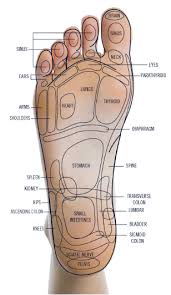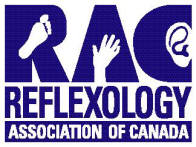
Reflexology
WHAT IS REFLEXOLOGY?
Reflexology is a natural, non-invasive therapy embracing the whole concept of holistic treatment. Based on the principle that there are reflexes in the feet, hands and ears, which correspond to every part, gland and organ of the body, a reflexologist will stimulate the nerve endings to send messages along the nerve pathways to the various organs and the body. Reflexologists approved by the Reflexology Association of Canada use specific techniques and pathways to ensure the entire foot is covered.
Simply, your Reflexologist presses with various pressure, thumbs, fingers, and knuckles on the zones on your foot in a specific way, similarly to acupressure.
This helps to balance the energies within the body. We treat an existing imbalance in the energy of the body, treating the whole body in a gentle, non-invasive manner that has no adverse side effects. We encourage the body to heal itself.
Reflexology relieves tension, improves circulation, and helps the body to normalize itself naturally.
Reflexology is completely safe for most people, with very few contraindications. Reflexology is safe and drug-free, so any person can begin reflexology treatments as soon as they wish.
WHO ARE REFLEXOLOGISTS?
To become certified with the Reflexology Association of Canada, practitioners are required to complete a formal 35-hour course, a 15-hour home study workbook, 60 case studies, a 2-hour written exam, and a practical exam. The 60 case studies must be completed within one year from the start of the course.
To graduate with a Reflexology diploma as a practitioner/therapist with the School of Natural Health Sciences, practitioners are required to complete approximately 200 hours of study to complete a foundation course, with 8 module tests, 9 case studies, plus a written practical exam.
Reflexology offered by The School of Natural Health Sciences (SNHS) is an accredited course by the International College of Holistic Medicine ( I.C.H.M.), The International Institute for Complementary Therapies, The American Association of Drugless Practitioners, and The Australian Committee of Natural Therapies.
Reflexologists do not diagnose, prescribe or treat specific conditions.
VISITING A REFLEXOLOGIST
Prior to the first actual treatment, a client’s medical history is first discussed. The feet are then cleaned, thoroughly inspected for any common foot problems or pathogens, and warmed up using a variety of gentle manipulation techniques. The treatment begins with the reflexologist “walking” with his/her thumbs and fingers, along the bottom (plantar), top (dorsal), and sides (medial and lateral) of the feet, applying pressure to specific areas or reflex points. Depending on the needs of the client, a reflexologist will vary the amount of pressure on the different areas of the foot, hand, or ear. For a gentle and soothing finish, foot cream is massaged into the feet or hands at the end of the reflexology treatment. The entire treatment requires approximately an hour.
If it is your first session, prepare to arrive 15 minutes early, as there are health forms to fill out. Have your feet as clean as possible (which I understand can be a challenge if you are coming on a lunch break or halfway through the day – not to worry, I also clean your feet with witch hazel before your session.) Also, be sure to have your nails clipped. Wear comfortably fitting clothing so your whole body will be able to relax.

